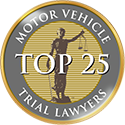
As parents, we want to protect our children in every situation. Unfortunately, even the everyday, the average car ride can pose a significant danger if your child is not safely secured in the right car seat. At Spaulding Injury Law, we know how many options there are out there for car seats. Personal injury attorney Ted Spaulding has four children himself, including one younger than 1. He and his wife have plenty of firsthand knowledge from researching car seats, installing them, swapping them out, and buckling up little ones. As an Atlanta motor vehicle accident lawyer, Ted has also seen how a good car seat can protect a child in the event of a crash. That’s why he wants to empower parents to choose the best car seat for their children.
Selecting the Right Type of Car Seat Based on Your Child’s Age
INFANTS & TODDLERS
Rear-Facing Car Seats: From birth to 12 months, your child should be secured in a rear-facing car seat. These seats are designed to cradle your little one’s body and protect your baby’s neck and spinal cord. Keep your child in this type of seat for as long as possible (until he or she outgrows the height and weight limit). Typically, children can stay in a rear-facing car seat until they are 2 or even 3 years old.
TODDLERS & PRESCHOOLERS
Forward-Facing Car Seats: When your little one outgrows the rear-facing seat, he or she will graduate to a forward-facing car seat with a harness and tether. This type of seat helps limit your child’s movement in case of an accident. Children typically move into these seats around the age of 2 or 3. They may continue to use them into their early elementary school years, depending on height and weight limits.
SCHOOL-AGE CHILDREN
Booster Seats: Children should transition to a booster seat when they outgrow their forward-facing seat. The booster seat ensures your child is in the correct position for the car’s seat belt to fit properly. Children in booster seats should remain in the back seat.
When to Move to the Next Seat?
Check the manufacturer’s height and weight limits. Do not move your child into the next type of car seat until your kiddo reaches those limits.
Which Car Seat is The Best Choice for Your Baby?
It’s easy to get overwhelmed by the number of car seat choices out there. Depending on how far ahead you want to plan, you could purchase:
- Infant-Only Car Seat (rear-facing)
- Convertible Car Seat (changes from rear-facing to forward-facing)
- Combination Car Seat (changes from forward-facing to booster)
- All-in-One Car Seat (changes from rear-facing to forward-facing seat to booster)
- Booster Seat with High Back (for head and neck support)
- Backless Booster Seat
Installing Your Car Seat
First-time parents can attest to the frustrations (and fears) of installing a car seat. Check both your vehicle’s owner’s manual and the car seat instructions to ensure you are installing it properly.
LOWER ANCHORS
Many cars have lower anchors in the back seat. Check in the seat’s crevice where the regular seat belt buckles are found. The car seat will clip into these anchors on either side.
TETHER ANCHOR
Most cars have tether anchors to secure the top of a forward-facing car seat to the vehicle. Look for the tether anchors on the back of the back seat, on the rear shelf, or on the ceiling.
SEAT BELT
If necessary, you can use the car’s seat belt to secure the car seat. But do not use this in addition to the anchors and tether
You Are Not Alone! A Car Seat Inspector Can Help!
A certified technician can install and inspect your car seat for free, in most cases. Find a car seat inspection station near you.
REGISTERING YOUR CAR SEAT
Be sure to fill out and mail in the registration card for your car seat. This allows the manufacturer to notify you in case of a recall.
CHECKING FOR CAR SEAT RECALLS
You can check for recalls by calling the National Highway Traffic Safety Administration Vehicle Safety Hotline at 1-888-327-4236 or by visiting the NHTSA website.









